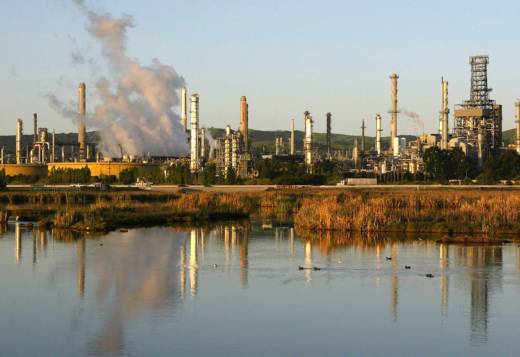The lack of information on the release angers environmentalists.
"It's pretty troubling what we know and what we don't know," said Hollin Kretzmann, a staff attorney at the Center for Biological Diversity, who read the company's report. "What Shell isn't telling us is what other toxic contaminants might have been released."
Earlier this month Shell revealed that the flaring restarted a day after the power outage. Altogether, close to 5,000 pounds of sulfur dioxide was released into the air on those two days, the company said in a letter to the Contra Costa County Health Services Department.
Shell spokesman Ray Fisher said the incident was "minor."
Another company representative, Ann Notarangelo, stressed that while close to 39,000 pounds of light hydrocarbons and hydrogen sulfide were released to one of its flares, that's not necessarily the same amount of gas that was released into the air.
"We don't release specifics beyond what's in the public record of our reports to the county and the EPA, but what comes out of the flare is primarily a combination of carbon dioxide and water," Notarangelo said in an email.
That answer does not sit well with Kretzmann.
"Shell's refusal to come clean on its dangerous air emissions ought to be a wake-up call for local officials," Kretzmann said. " 'We don't release specifics' is a completely unacceptable position, given the dangers of these air pollutants, and demonstrates Shell's contempt for public health and safety."
The other gases that could have been released include water vapor, carbon dioxide, carbon monoxide, nitrous oxides and other hydrocarbons, according to Randy Sawyer, Contra Costa County's chief environmental health and hazardous materials officer.
Local air regulators, who are investigating Shell's malfunction, haven't revealed the chemical makeup of the release either.
The Bay Area Air Quality Management District, which launched an investigation on the day of the outage, has not released any information about its probe.
Shell and other oil companies that operate refineries in the Bay Area consistently emphasize that flaring is a safe way to relieve pressure, burn gases and operate safely.
Experts note that the technique averts major disasters but unfortunately releases toxic chemicals into the air.
Shell's December breakdown, instead, highlights concerns about the refinery's old equipment and need for better training, according to Alexandra von Meier, an adjunct professor at UC Berkeley's Department of Electrical Engineering and Computer Science.
"I feel for the guy who wiggled the relay, and bam, the lights go out," said von Meier, who reviewed Shell's investigation.
The company's electrical staff "had an incorrect mental map" and "misinterpreted the connections between different parts of the system," von Meier said.
Shell bought the substation at the center of the outage from PG&E more than 30 years ago.
"It is an outdated and dangerous piece of equipment that should have been taken care of by the company but just wasn't," Kretzmann said.
Shell plans to spend the next year implementing changes to avoid a repeat. That will include adding more electrical staff to troubleshoot circuit breaker problems and adding labels that show which devices could lead to outages, according to its 30-day report.
Contra Costa County officials plan to ensure the reforms are made when they audit the Martinez refinery in the next few years, Sawyer said.
The Shell incident was one of several Bay Area refinery malfunctions blamed for a recent rise in California gas prices.
